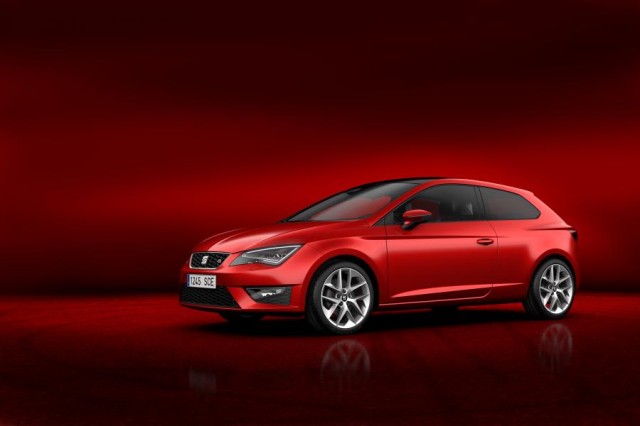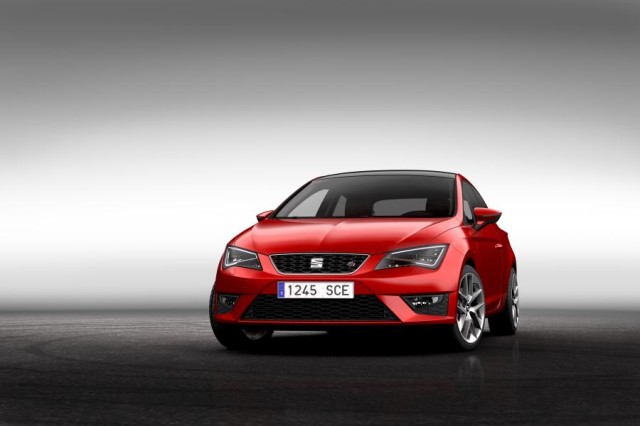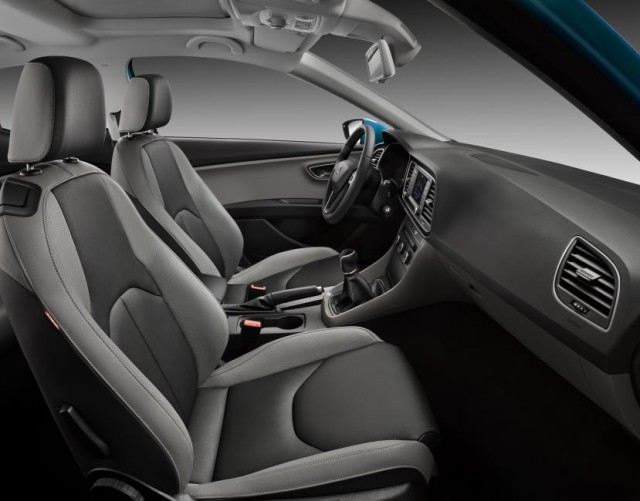


SEAT has unveiled the all-new Leon SC at the 2013 Geneva Motor Show. The beautiful new three-door coupé represents the second stage of the launch of a new model family, which will by the end of 2013 comprise five-door hatchback, three-door SC, and ST estate.
This new three-door version breaks new ground for SEAT – the Leon has never been available as a three-door before – and will be instrumental in increasing sales because it will broaden SEAT’s market coverage in the most popular segment in Europe.
Redesigned from the A-pillars back, the Leon SC is much more than simply a three-door version of the five-door Leon hatchback. With a more steeply raked rear screen, a lower roofline, broad rear shoulders including sharp blisters over the wheel arches, and a new profile for the rear three-quarter windows, the Leon SC truly has the look of a true coupé.
However, it remains extremely practical, with the same 380-litre boot capacity as the five-door Leon and outstanding front- and rear-headroom.
This morning SEAT President James Muir defined the Leon SC as a vehicle “designed to be the most beautiful car in its segment,” adding that it will “bring a new generation of customers to SEAT.”

Muir underscored the excellent reception that the five-door Leon – unveiled at the 2012 Paris Motor Show – has already enjoyed, and demonstrated the promising start to the 2013 that SEAT has made. “To date we have delivered nearly 10,600 vehicles, and currently have an order-bank of 15,000 units,” he said, adding that SEAT “is already seeing the first signs of the product offensive launched in 2012 paying off. We face 2013 with the same energy, motivation and optimism to grow with the new products as well as increased presence in developing markets.”
As is the case with the five-door version, the new Leon SC will be built at Martorell (Barcelona) using the Volkswagen Group’s ground-breaking MQB platform. Compared to the five-door version, the Leon SC has a 35mm shorter wheelbase. The use of advanced materials in production makes the Leon SC the lightest vehicle in its class – it is 110 kg lighter than the second-generation Leon, and 20 kg lighter than the five-door new Leon – providing improved handling and efficiency. Like the five-door version, the Leon SC is equipped with engines ranging from 105 PS to 184 PS; from launch the Leon SC will feature the same engine and trim range as the five-door, including the 1.6 TDI 105 PS with just 99 g/km CO2, and later in the year, the rapid-yet-frugal 2.0 TDI 184 PS FR.
The new Leon SC will be in dealerships in July 2013, with order books opening in April.
New Mii Ecofuel, the cleanest model in SEAT’s history
SEAT has broadened the Mii range with the arrival of the Mii Ecofuel, a production car with the lowest CO2 emissions in the company’s history. Its CO2 emissions figure, just 79 g/km, is best-in-class. The Mii Ecofuel, is the brand’s first model to run on compressed natural gas (CNG), providing outstanding efficiency and low maintenance costs – roughly half those of a petrol-powered Mii, with a weighted consumption of only 2.9 kg of CNG/100 km. On that basis, the cost of fuel to cover 100 km is less than three euros.*
The Mii Ecofuel, shown for the first time at the 2013 Geneva Motor Show, demonstrates that being genuinely eco-friendly needn’t come at the expense of fun driving dynamics. Its engine is based on the 1.0-litre, three-cylinder unit already found in the Mii, but specifically designed to run on CNG. It can still run on unleaded fuel, however. Its range with a full CNG tank (11 kg) is 240 miles, and it has an additional 10-litre petrol tank, adding another 140 miles, giving it a 380-mile total tank range.
The Mii Ecofuel is already on sale in markets like Germany, Italy, Austria, Switzerland and the Netherlands, where highly-developed networks already exist to cope with the demand for natural compressed gas. There are currently no plans to sell the car in the UK.
Product offensive improves SEAT sales
At the start of the current year SEAT began to reap the rewards of the new Mii, Ibiza, Toledo and Leon launches during 2012. In January and February SEAT’s worldwide deliveries increased by some 14%, with very significant improvements in Germany, Spain, the United Kingdom, Mexico and Algeria. Additionally SEAT is the fastest-growing brand in Germany, where it has entered the top ten.
The Spanish company has continued to grow beyond Europe in the first two months of the year. In 2012, SEAT sales outside Europe improved by 46%, accounting for 18% of total sales − seven points up on 2011 − thanks to results in Mexico, where SEAT broke through the 20,000 unit barrier; in Algeria, where sales increased four-fold in just one year, totalling 16,000 vehicles; and in Israel, where since 2008 the number of units sold has increased five-fold, exceeding 6,000. In January and February 2013, SEAT sales outside Europe were up 37% on the same months in 2012. Today one of every five SEAT cars is sold in non-European markets.
SEAT is the only company in its sector with the full-range capacity to design, develop, manufacture and market cars in Spain. A member of the Volkswagen Group, the multinational has its headquarters in Martorell (Barcelona), exporting 80% of its vehicles to 75 countries.

SEAT Group employs more than 14,000 professionals at its three production centres in Barcelona- Zona Franca, El Prat de Llobregat and Martorell, where it manufactures the highly successful Ibiza and Leon, amongst other models. Additionally, the company produces the Alhambra in Palmela (Portugal), the Mii in Bratislava (Slovakia) and the new Toledo in Mladá Boleslav (Czech Republic) at Volkswagen Group plants.
The Spanish multinational also has a Technical Center, a “knowledge hub”, bringing together more than 900 engineers whose goal is to be the driving force behind innovation for the number one industrial investor in R&D in Spain. In line with its declared commitment to environment protection, SEAT undertakes and bases its core activity on sustainability, namely reduction of CO2 emissions, energy efficiency, as well as recycling and re-use of resources.










